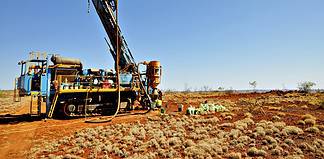AngloGold Ashanti rounded out 2018 on a high as it continues to reap the rewards of its streamlined portfolio. Image: Anglogold.
BY GERARD MCARTNEY
AFTER a strong first half, AngloGold finished 2018 with a positive return on its strategy of letting go low performing assets.
AngloGold’s two Australian mines, Tropicana and Sunrise Dam, performed exceptionally in the 12 months leading up to 31 December 2018, and after a feasibility study was completed, Tropicana would begin underground mining.
In 2017, outgoing chief executive, Srinivasan Venkatakrishnan closed the South African Tau Tona mine, and in 2018 completed the sale of the South African Moab Khotsong and Kopanang mines, and reduced ore reserve development amortisation in Brazil.
Newly appointed chief Kelvin Dushnisky, who transitioned from Barrick to AngloGold on 21 September, has continued to promote Mr Venkatakrishnan’s vision, recently initiating processes to sell the company’s interests in the Cerro Vangaurdia mine in Argentina and Sadiola mine in Mali.
“The portfolio seems a little heavy, so we’ll be doing some streamlining,” Mr Dushnisky said.
“We’re going to be stubborn in our decision making process, and the reality is that some options in the pipeline won’t make the grade.”
In its Year End 2018 Report, the company reiterated its philosophy of “a clear and uncompromising method of allocating capital, which means that investments may not be made if the returns they offer rank below other available opportunities within the portfolio”.
The company’s ambition to sharpen its focus on low-cost, high earning projects appeared to be paying off, after it achieved guidance for the sixth consecutive year and reported headline earnings of $US220 million, up from $US27 million in 2017.
After paying a one-time, $US46 million settlement for a silicosis class action, and $US25 million in costs associated with restructuring the South African business, the company generated $US67 million in free cash flow, up from $US1 million in 2017.
“This is a strong operating performance that shows our commitment to meeting our guidance targets and improving our margins,” Mr Dushnisky said.
“We have a clear set of return and leverage targets that will guide our investments.”
AngloGold’s work to trim the fat off its portfolio had seen the company continue to pull resources out of Africa, but a complete exit from the continent, and its South African home may be a long time off.
The company looked set to stay in South Africa and would not exit the world’s deepest mine at Mponeng, that it said would still be operational in 2036.
The redeveloped Obuasi mine was on track to produce its first gold by the end of 2019, and should be at full scale production by 2020.
“Goldstrike was to Barrick what I believe Obuasi will be to AngloGold Ashanti,” Mr Dushnisky told delegates at the Mining Indaba conference in February.
“We need those big, chunky engines of growth, which year after year provide reliable, predictable production and they don’t come along very often.”
Australian Highlights
AngloGold’s Australian projects processed 625,000 ounces in FY18, up from 559,000oz in FY17.
Higher mill-feed grades contributed to a 21 per cent increase in production at Sunrise Dam, which delivered 289,000oz.
A number of one-off capital projects were completed at Sunrise Dam in 2018, such as the construction of the $28 million recovery enhancement project (REP), a multi-year extension to the tailings storage facility, and the installation and commissioning of two 2MW primary ventilation fans.
This year, the company would focus on stabilising the REP at design levels.
Meanwhile, AngloGold’s Tropicana joint venture with Independence Group (70 per cent and 30 per cent respectively) produced its 2 millionth gold ounce in 2018, and had increased its overall production by five per cent in 2018.
A second 6MW ball mill was installed and commissioned ahead of schedule in November, which increased the throughput and improved the metallurgical recovery.
The mine produced 336,000oz of ore, compared with 321,000oz in 2017.
In addition, the joint venture partners’ undertook a pre-feasibility study that confirmed underground mining at the Boston Shaker pit was financially viable and, in December 2018 they announced that a feasibility study into the development of an underground mine was underway, with financial commitment and operations set to start in FY21.
The project was expected to cost about $100 million to convert the operation from open cut mining into underground.
Once underground, the mine was expected to produce about 100,000oz per year, over the seven year life of the mine.
Outlook
AngloGold expected to produce between 3.25 million ounces and 3.45 million ounces in FY19.
In a recent announcement, the company said production would be back weighted, with a stronger second half expected for Geita and Siguri.
Exploration would remain a key focus in coming months at Tropicana’s Boston Shaker underground, Havana underground and satellite targets within the tenement.
After successful intercepts during exploration at Sunrise Dam through 2018, the focus would continue to dip and strike extension and shallow underground potential up-dip of current orebodies.
“In order to create value in the long term, and without resorting to expensive and often complex NMA, it is important to ensure consistent investment in exploration,” Mr Dushnisky said.
Other priorities for the company included advancing Obuasi for first production towards the end of the 2019 calendar year.
“We’ll continue to place a clear emphasis on getting the basics right, that includes meeting our guidance, always, and strengthening our licence to operate,” he said.
“We’ll keep a sharp focus on cost and managing capital.
“We’ll build on recent efficiency improvements using operational excellence across the business to continue to move down the cost curve.”








































